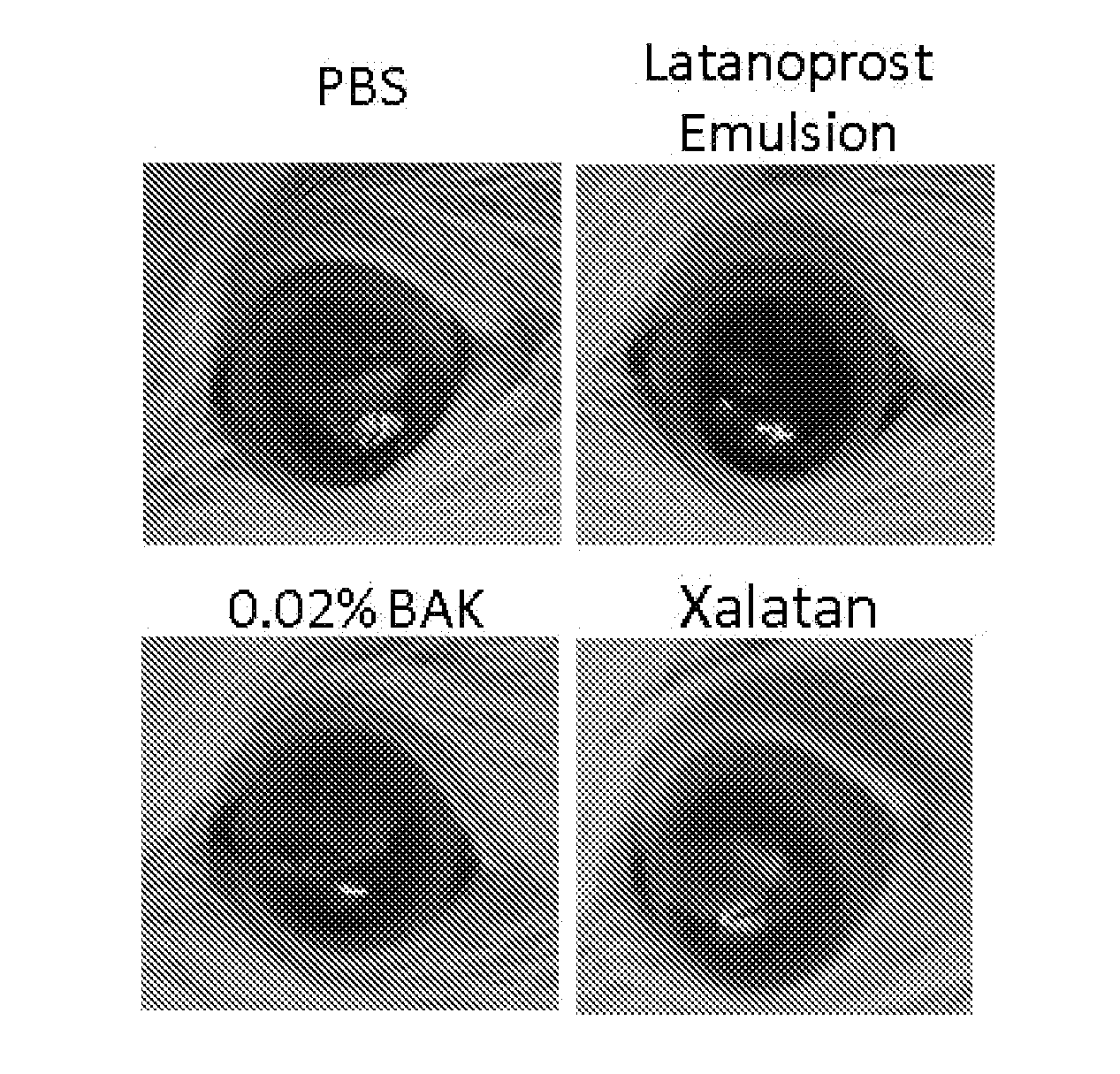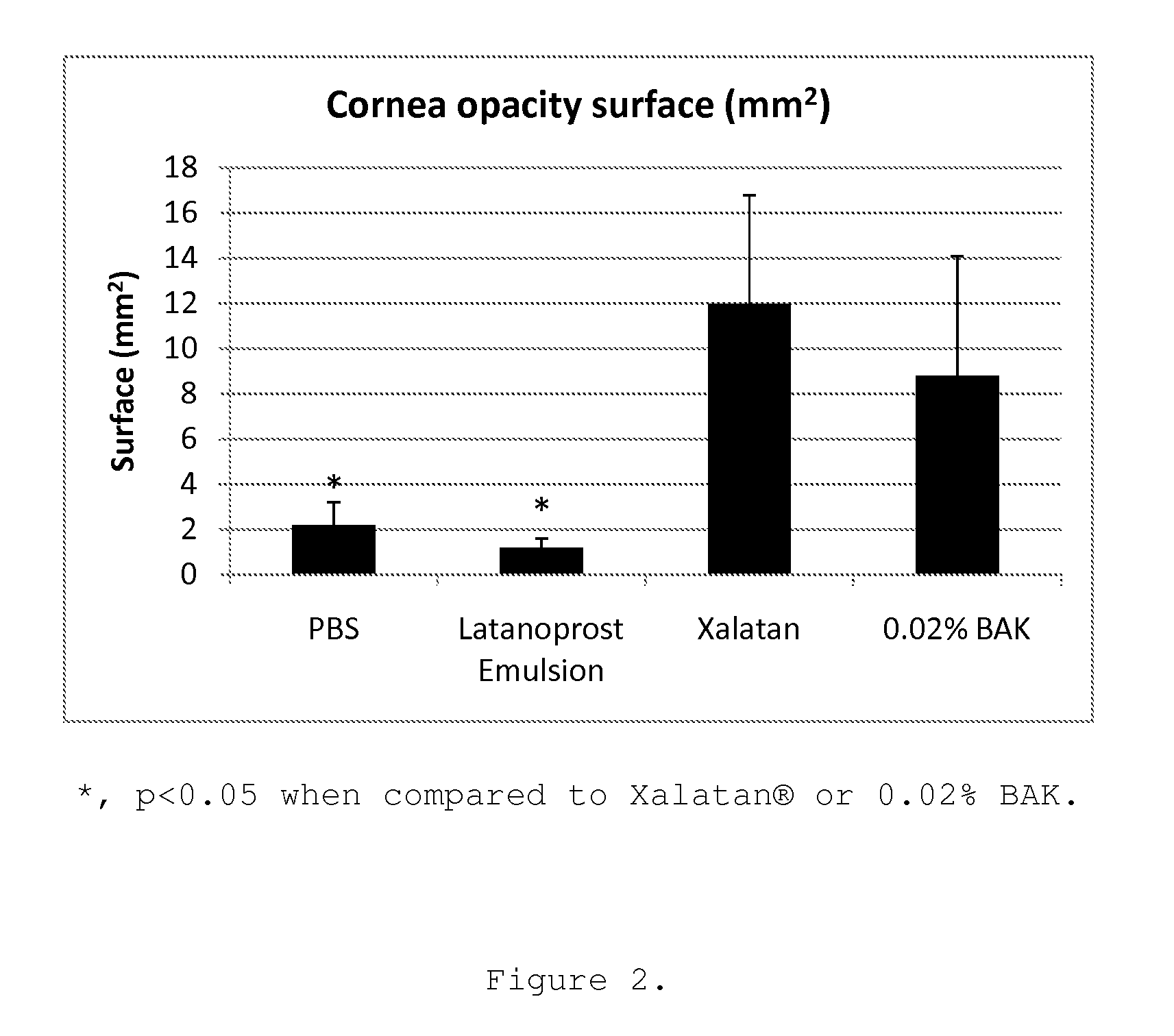Use of Prostaglandins F2Alpha and Analogues for the Healing of Corneal and Conjunctival Lesions
a technology of prostaglandins and analogues, applied in the field of corneal and conjunctival lesions healing, can solve the problems of increased discomfort and sensitivity to bright light, harmful and painful lesions, sandy-gritty eye irritation,
- Summary
- Abstract
- Description
- Claims
- Application Information
AI Technical Summary
Benefits of technology
Problems solved by technology
Method used
Image
Examples
example 1
In Vivo Experiments
[0077]Brief description of the protocol: 16 male Sprague-Dawley rats weighting 100 to 125 g were randomly assigned to 4 groups (4 rats per group (Gp)): Gp1, Phosphate buffer solution (PBS); Gp2, 0.02% benzalkonium chloride (BAK); Gp3, Xalatan®; Gp4, Latanoprost Emulsion. Following general and local anesthesia with ketamine / xylazine and topical Oxybucaïne, respectively, the upper part of the right eye cornea of each rat was scraped with a surgical scalpel following an application of 50 μl of 50% ethanol solution. The upper corneal and limbal epithelia were removed (at day D0). One drop of Tobrex was instilled immediately after the scraping. 2 and 5 hours post scraping one drop of the different test articles were applied onto the cornea of the right eye. These latter instillations were repeated every day for 4 days, and corneal evaluation with an in vivo confocal microscope (IVCM-HRT) was performed on day 4 after the last instillation. At the end of the experimental...
example 2
in Vitro Experiments
[0084]Brief description of the protocol: human corneal epithelial (HCE) cells (100 000 cells per well) were plated in 6-well plates and cultured until confluence. At confluence the cell monolayer was scraped with a yellow tip, the medium removed and incubated for 30 min with 1 / 10 dilutions of the different test articles (PBS (phosphate buffer solution), Xalatan® (aqueous solution of latanoprost at 0.005%), 0.02% BAK (benzalkonium chloride aqueous solution), and the Latanoprost Emulsion of the invention (with 0.005% latanoprost). Following the treatment, test article dilutions were removed and replaced by fresh culture medium. The scraping closure was assessed 2 and 24 h post treatment. Immunohistology of proliferation marker (Ki67) was also performed on cells cultured for 24 h post scraping.
[0085]Results: 2 and 24 h after the scraping, pictures of the cell monolayer were taken to assess the efficacy of the different treatment on the scraping closure. Clearly, the...
example 3
Compositions of Prostaglandin F2alpha
[0088]
Composition 1IngredientFunction% w / wTravoprostActive Ingredient0.002%Polysorbate 80Wetting agent0.050%GlycineOsmoprotecting agent 0.5%ErythritolOsmoprotecting agent 0.5%Water for InjectionDiluentAd 100%NaOH / HCl 0.1MpH adjuster during manufacturing
[0089]Composition 1 combines 3 mechanisms of action: a prostaglandin F2alpha analogue, a wetting agent polysorbate 80, two osmoprotectants plus a hypoosmotic effect to protect corneal cells.
Composition 2IngredientFunction% w / wAcid free latanoprostActive Ingredient0.0005%Vitamin AHealing agent 0.005%GlycerinOsmotic agent 1.6%Polyvinyl alcoholLubricating agent 1.0%Water for InjectionDiluentAd 100%NaOH / HCl 0.1MpH adjuster during manufacturing
[0090]Composition 2 combines three mechanisms of actions: a prostaglandin F2alpha analogue, vitamin A and a lubricating agent plus a hypoosmotic effect to protect corneal cells.
Composition 3PhaseIngredientFunction% w / wOilyLatanoprostActive Ingredient0.005%phaseM...
PUM
| Property | Measurement | Unit |
|---|---|---|
| concentration | aaaaa | aaaaa |
| weight | aaaaa | aaaaa |
| pressure | aaaaa | aaaaa |
Abstract
Description
Claims
Application Information
 Login to View More
Login to View More - R&D
- Intellectual Property
- Life Sciences
- Materials
- Tech Scout
- Unparalleled Data Quality
- Higher Quality Content
- 60% Fewer Hallucinations
Browse by: Latest US Patents, China's latest patents, Technical Efficacy Thesaurus, Application Domain, Technology Topic, Popular Technical Reports.
© 2025 PatSnap. All rights reserved.Legal|Privacy policy|Modern Slavery Act Transparency Statement|Sitemap|About US| Contact US: help@patsnap.com



